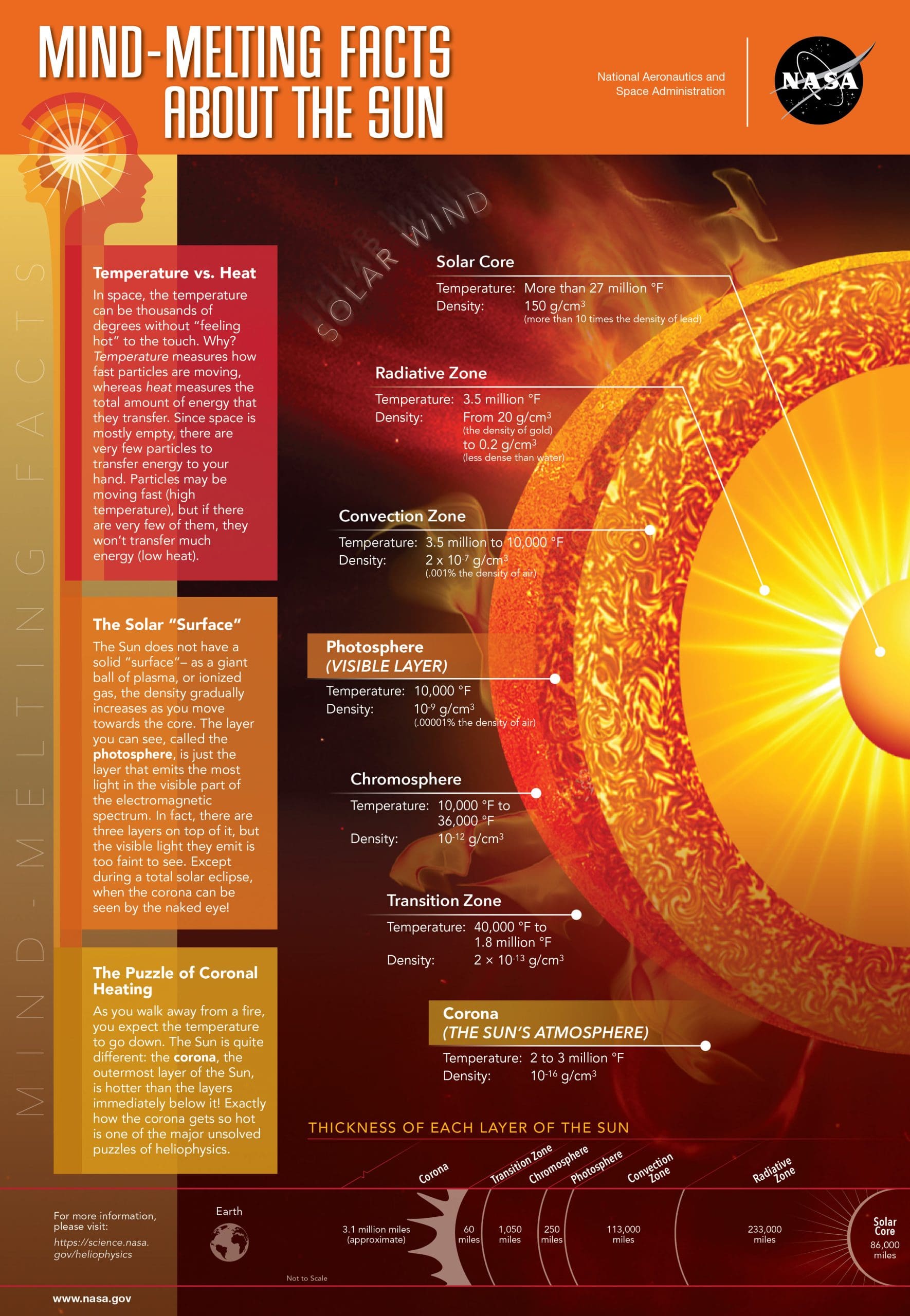The Sun
The Sun is 150 million kilometer s (93 million miles) away from the Earth (this distance varies slightly throughout the year, because the Earth’s orbit is an ellipse and not a perfect circle).
Why is the Sun green? It’s false color from Solar Dynamics Observatory (SDO) data of the SDO AIA 131 Angstrom – AIA 131 Å wavelength. This shows the hottest material in a flare. It measures extremely hot temperatures around 10 million K (18 million F), as well as cool plasmas around 400,000 K (720,000 F)! CREDIT: SDO
The Sun is an average star – there are other stars which are much hotter or much cooler, and intrinsically much brighter or fainter.
However, since it is by far the closest star to the Earth, it looks bigger and brighter in our sky than any other star. With a diameter of about 1.4 million kilometer s (860,000 miles) it would take 110 Earths strung together to be as long as the diameter of the Sun.The Sun is mostly made up of hydrogen (about 92.1% of the number of atoms, 75% of the mass). Helium can also be found in the Sun (7.8% of the number of atoms and 25% of the mass). The other 0.1% is made up of heavier elements, mainly carbon, nitrogen, oxygen, neon, magnesium, silicon and iron. The Sun is neither a solid nor a gas but is actually plasma . This plasma is tenuous and gaseous near the surface, but gets denser down towards the Sun’s fusion core .
Stars like the Sun shine for nine to ten billion years. The Sun is about 4.5 billion years old, judging by the age of moon rocks. Based on this information, current astrophysical theory predicts that the Sun will become a red giant in about five billion (5,000,000,000) years.
See the Sun in Different Lights!
Viewing the Sun from spacecraft allows us to view it in different wavelengths of light. The data is compiled with false colors (each color always equals the same wavelength) to show the activity happening on and from the Sun.

NASA’s Jim Green interviews Nicky Fox about the sun. Listen below.
We start our “Gravity Assist” virtual tour of the solar system with – where else – the Sun! How hot is the Sun, what are solar flares, and how does space weather affect us here on Earth? Jim is joined by Project Scientist Dr. Nicky Fox of the Johns Hopkins University Applied Physics Lab to talk about our fascinating star and NASA’s upcoming Parker Solar Probe—a mission to “touch the Sun.”
CREDIT: Gravity Assist, The Sun with Nicky Fox by NASA is licensed under a Creative Commons License.
Sun Facts
- The sun is the largest object in the solar system
- The sun contains more than 99.8% of the total mass of the Solar System (Jupiter contains most of the rest).
- The sun is the closest star to Earth
- The sun is an average star, its size, age, and temperature fall in about the middle of the ranges of these properties for all stars.
- Some in our galaxy are nearly as old as the universe, about 15 billion years, our sun is a 2nd-generation star, only 4.6 billion years old.
- Some of the sun’s material came from former stars.
- We’ve always known the sun, unlike many other objects in our solar system, the sun has been known to humans since the dawn of time. There is no discovery date or discoverer.
- Since its creation, the sun has used up about half of the hydrogen in its core
- The solar “surface,” known as the photosphere, is just the visible 500-km-thick layer from which most of the Sun’s radiation and light finally escape, and it is the place where sunspots are found.
- Above the sun’s photosphere lies the chromosphere (“sphere of color”) that may be seen briefly during total solar eclipses as a reddish rim, caused by hot hydrogen atoms, around the Sun.
- The corona (“crown”) is above the chromosphere, extending outward from the Sun in the form of the “solar wind” to the edge of the solar system.
- One unsolved mystery of the sun involves the corona (“crown”), why is extremely hot – millions of degrees kelvin.
- It is physically impossible to transfer thermal energy from the cooler surface of the Sun to the much hotter corona, the source of coronal heating has been a scientific mystery for more than 60 years.
- The Greeks named the sun Helios, the Romans used the name Sol, which is still in use today.
- Ulysses was the first spacecraft to study our Sun’s poles.
- The sun’s strong gravitational pull holds Earth and the other planets in place.
- The sun is made up of distinctive areas In addition to the energy-producing solar core, the interior has two distinct regions: a radiative zone and a convective zone.





